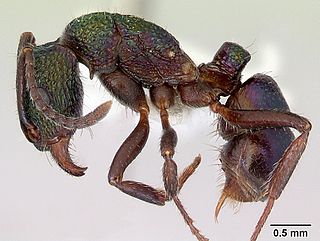
Dolichoderinae is a subfamily of ants, which includes species such as the Argentine ant, the erratic ant, the odorous house ant, and the cone ant. The subfamily presents a great diversity of species throughout the world, distributed in different biogeographic regions, from the Palearctic, Nearctic, Afrotropical region and Malaysia, to the Middle East, Australian, and Neotropical regions.

Rhytidoponera is a large genus of ants in the subfamily Ectatomminae. The genus is known from Australia and Melanesia, with New Caledonia as the most eastern limit.

Meranoplus is an Old World genus of ants in the subfamily Myrmicinae. With over 80 valid species, it is predicted that over half of the Meranoplus diversity remains undescribed, most of these from Australia.

Myrmecia pyriformis, also known as the bull ant, is an Australian ant. Myrmecia pyriformis belongs to the genus Myrmecia. It is abundant in many major cities of Australia, but mostly spotted in the eastern states. The species is of a similar appearance to the Myrmecia forficata.
Myrmecia analis is a species of the genus Myrmecia. Myrmecia analis is usually only found in Western Australia. It was described by Mayr in 1862.

Myrmecia nigrocincta, commonly known as the jumper ant or jumping jack, is an ant of the genus Myrmecia. The species was first described by Frederick Smith in 1858. Colonies of this ant are abundant in eastern Australia. Ants of this species are known for their ability to jump up to 10 centimetres, and they also have a powerful, venomous sting. Rather than foraging on the ground, M. nigrocincta prefer to forage in trees where they are known to pollinate certain flowers.
Myrmecia ludlowi is an Australian ant which belongs to the genus Myrmecia. This species is native to Australia and is commonly distributed in Western Australia. They were first described by Crawley in 1922.

Myrmecia auriventris is an Australian ant which belongs to the genus Myrmecia. This species is native to Australia and is commonly distributed in Queensland.
Myrmecia clarki is an Australian ant which belongs to the genus Myrmecia. This species is native to Australia and is commonly distributed in Western Australia.

Myrmecia regularis is a species of ant endemic to Australia. A member of the genus Myrmecia in the subfamily Myrmeciinae, it was first described by American entomologist Walter Cecil Crawley in 1925. These ants are medium to large in size, measuring 10 to 20 millimetres, and they are bright brownish-red in colour. Queens and workers share similar morphological features, but they can be distinguished by the noticeable size difference. Males also look similar, but collected specimens are too damaged to be examined properly.
Myrmecia swalei is an Australian ant which belongs to the genus Myrmecia. This species is native to Australia and is commonly distributed in Western Australia and South Australia. It was described by Crawley in 1922.
Myrmecia varians is an Australian ant which belongs to the genus Myrmecia. This species is native to Australia. The Myrmecia varians is one of the most distributed ants in the country, with the species being observed in every single state and territory except for Tasmania. Myrmecia varians was first described by Mayr in 1876.

Arnoldius flavus is a species of ant of the genus Arnoldius, one of only three species described in it. Native to Australia, it was described by Crawley in 1922.
Arnoldius pusillus is a species of ant part of the genus Arnoldius, which is only one of the three species described in it. The species is distributed in Australia. It was described by Mayr in 1876.

Iridomyrmex chasei is an ant belonging to the genus Iridomyrmex. The species was described by Forel in 1902, the species is mainly abundant nationwide in Australia, with an exception of its presence in Tasmania. This species is widely known for its large and highly populated nests.
Dolichoderus niger is a species of ant in the genus Dolichoderus. Described by Crawley in 1922, the species is endemic to Australia, and can be seen in scrub like habitats in Western Australia, and has been observed in native woodland around the city of Perth.

The black-headed sugar ant, also known as the brown sugar ant, is a species of Formicinae ant endemic to Australia. Found throughout most states, the species is a member of the genus Camponotus, a cosmopolitan genus of ants commonly known as carpenter ants. It was formally described and named by British entomologist Frederick Smith in 1858. These ants are characterised by their black head, reddish-brown mesosoma and black gaster, which can change in colour.











